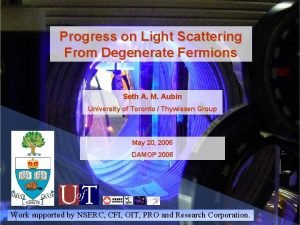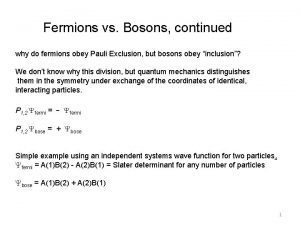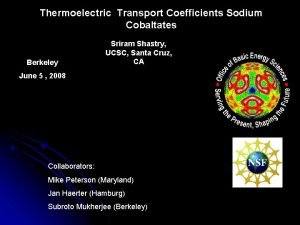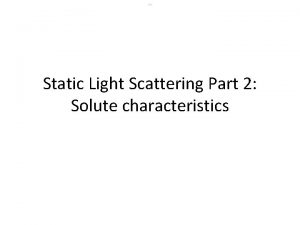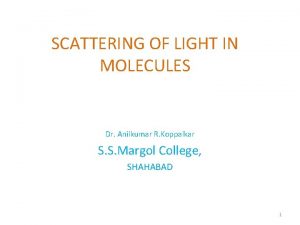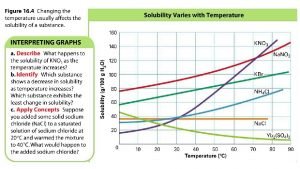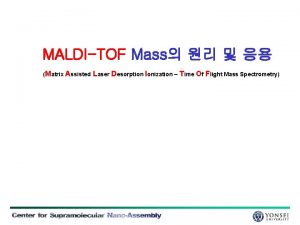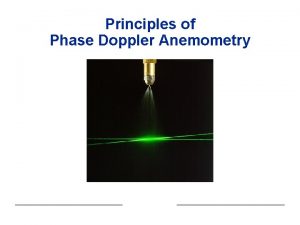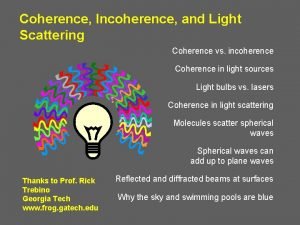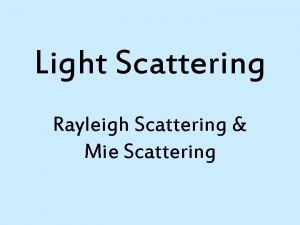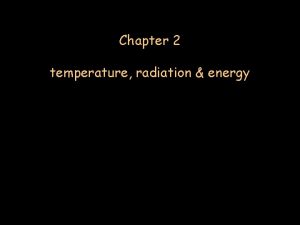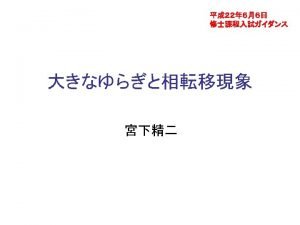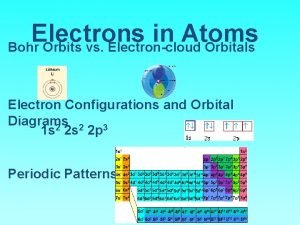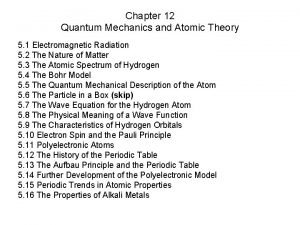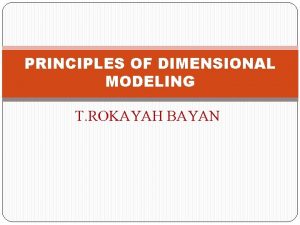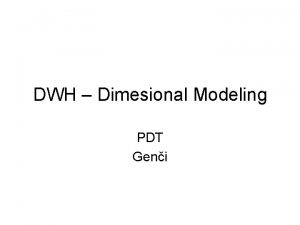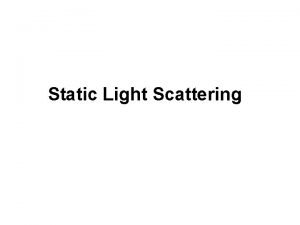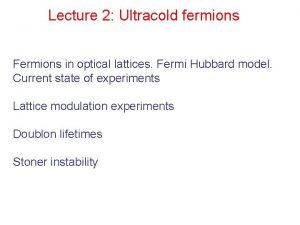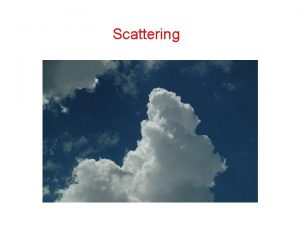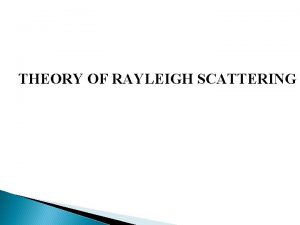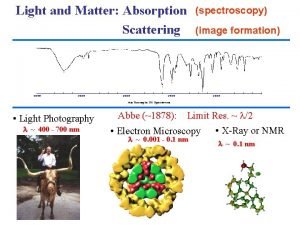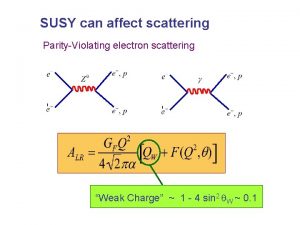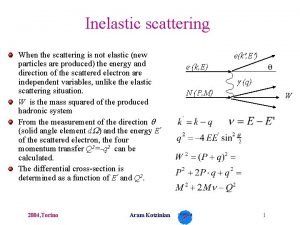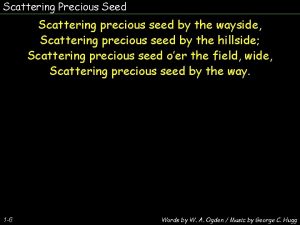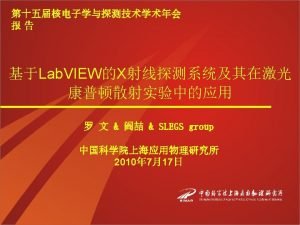Progress on Light Scattering From Degenerate Fermions Seth





















- Slides: 21

Progress on Light Scattering From Degenerate Fermions Seth A. M. Aubin University of Toronto / Thywissen Group May 20, 2006 DAMOP 2006 Work supported by NSERC, CFI, OIT, PRO and Research Corporation.

Outline Ø Motivation Ø Apparatus Ø Light Scattering: Simple approach Ø Light Scattering: next generation

Light Scattering with Fermions Objective: Modify the lifetime/linewidth of an excited state with quantum statistics. Motivation: Ø Trapping environment reduces the number of recoil states lifetime increases. Ø Analogous phenomena observed in cavity QED systems. Ø Similar phenomena frequently observed in condensed matter systems. See for example, A. Högele et al. , Appl. Phys. Lett. 86, 221905 2005).

Rb + K


Signatures of Degeneracy 87 Rb Bose-Einstein Condensate: 104 - 105 atoms 0 Observation of Pauli Pressure EF Fermi-Dirac Statistics Boltzmann Statistics 200 400 Radial distance ( m) EK, release/EF Optical Density Fermion (40 K) momentum distribution 0. 1 TF with 4 104 40 K atoms S. Aubin et al. , Nature Physics (2006). k. TRb/EF

Signatures of Degeneracy 87 Rb Bose-Einstein Condensate: 104 - 105 atoms Fermion (40 K) momentum distribution Observation of Pauli Pressure Fermi-Dirac Statistics Boltzmann Statistics 0 EK, release/EF Fit Residuals EF 200 400 Radial distance ( m) 0. 1 TF with 4 104 40 K atoms S. Aubin et al. , Nature Physics (2006). k. TRb/EF

Light Scattering with Fermions: Simple Approach Degenerate Fermions: Pauli Blocking of light scattering Probe Laser Ø Fermi sea reduces number of states an excited atom can recoil into. DFG Ø Atomic lifetime increases, linewidth decreases. B. De. Marco and D. Jin, Phys. Rev. A 58, R 4267 (1998). Th. Busch et al. , Europhys. Lett. 44, 755 (1998). Erecoil = 0. 4 K EFermi = 1. 1 K k. F

Further difficulty with Fermions We want this process kx More likely process Fermi Sea kx krec oil kx Fermi Sea krec oil Almost no Pauli blocking. kx

Solution ? IDEA: different states can have different Fermi energies/momentum (i. e. different populations), but still be in thermal equilibrium. Excite mf = 7/2 atoms. kx Look for Pauli blocking of decay into mf = 9/2. Fermi Sea DFG, mf=7/2 krecoil kx Non-DFG, mf=9/2

How well does it work ? Suppression factor: M, suppresion factor EF, 2 = 4 Erecoil T=0 EF, 2 = 6 Erecoil EF, 2 = 8 Erecoil EF, 1 EF, 2 Theory for a spherical harmonic trap, based on: B. De. Marco and D. Jin, Phys. Rev. A 58, R 4267 (1998). Th. Busch et al. , Europhys. Lett. 44, 755 (1998).

Implementation 11/2 F = 11/2 9/2 7/2 Procedure: 5/2 Ø State preparation: prepare DFG in mf=7/2, and non-DFG in mf=9/2. Ø Apply weak excitation pulse (atom scatters less than 1 photon). Non. DFG 9/2 7/2 5/2 F = 9/2 Ø Measure population ratios Ø Look for a change in ratio as T is decreased.

Potential Difficulties Ø Rescattering of scattered light. far off resonance probe Ø Unwanted transitions to unsuppressed levels. dipole trap + large Zeeman splittings Ø Heating due to probe. short pulse

Dipole Trap Currently installing a 1064 nm dipole trap: Aligned with Z-wire trap. It works! ~100% loading efficiency with 87 Rb. Loading into the optical trap: 105 87 Rb atoms at ~ 1 µK

Summary EF Ø Degenerate Bose-Fermi mixture on a chip. Ø New scheme for light scattering with fermions Fermi Sea Ø Dipole trap installed. krecoil

Thywissen Group S. Aubin D. Mc. Kay B. Cieslak S. Myrskog M. H. T. Extavour A. Stummer T. Schumm Colors: Staff/Faculty Postdoc Grad Student Undergraduate L. J. Le. Blanc J. H. Thywissen

Atom Chip for Bose-Fermi mixtures Advantages: Ø Short experimental cycle (5 -40 s). Ø Single UHV chamber. Ø Complex multi-trap geometries. Ø On-chip RF and B-field sources. Trap Potential: Z-wire trap Chip by J. Esteve, Orsay.

Simple Version 11/2 F = 11/2 9/2 7/2 Procedure: Ø State preparation: prepare DFG in mf=9/2, and nothing in mf=7/2. 5/2 Ø Apply weak excitation pulse to intrap atoms. (atom scatters less than 1 photon) Ø Use Stern-Gerlach to image the states separately. DFG empty 9/2 7/2 5/2 F = 9/2 Ø Measure population ratios. Ø Look for a change in ratio as T is decreased.

Cross-Section plot

Implementation #2 11/2 9/2 F = 11/2 7/2 5/2 9/2 7/2 F = 9/2 5/2 Procedure: Non. DFG 9/2 7/2 5/2 F = 9/2 Ø State preparation: prepare DFG in mf=9/2, and non-DFG in mf=7/2. Ø Apply 2 -photon excitation pulse (1 RF + 1 optical). Ø Look for a decrease in scattering rate as T is decreased.

Rb-K cross-section (nm 2) Sympathetical Cooling
 Pauli blocking of light scattering in degenerate fermions
Pauli blocking of light scattering in degenerate fermions Fermions obeys
Fermions obeys Fiducary
Fiducary Rayleigh theory of light scattering
Rayleigh theory of light scattering Rayleigh scattering formula
Rayleigh scattering formula Scattering of light
Scattering of light Scattering of light in suspension
Scattering of light in suspension Dynamic light scattering 원리
Dynamic light scattering 원리 Light scattering
Light scattering Coherent vs incoherent scattering
Coherent vs incoherent scattering Mie plot
Mie plot Vertical
Vertical Brightness and contrast
Brightness and contrast Physical progress and financial progress
Physical progress and financial progress Light light light chapter 22
Light light light chapter 22 Light light light chapter 23
Light light light chapter 23 Light light light chapter 22
Light light light chapter 22 Degenerate state
Degenerate state Define shell and subshell
Define shell and subshell Degenerate orbitals
Degenerate orbitals Dimensional modeling basics
Dimensional modeling basics Degenerate dimensions
Degenerate dimensions
